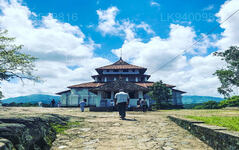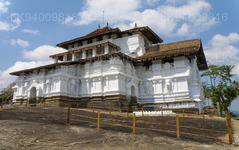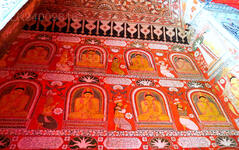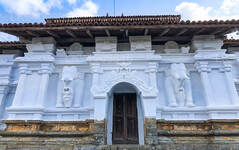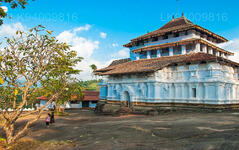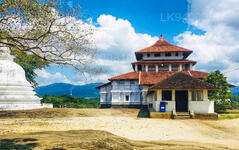
مدينة كاندي
كاندي، مدينة خلابة في وسط سريلانكا، تشتهر بتراثها الثقافي الغني ومهرجاناتها النابضة بالحياة وجمالها الطبيعي الأخّاذ. تقع وسط تلال خضراء، وتضم معبد السنّ، وهو موقع تراث عالمي لليونسكو، وتوفر مزيجًا آسرًا من التاريخ وروعة الطبيعة.
Lankathilaka Viharaya
Lankathilaka Viharaya in Sri Lanka: The Great Temple of the Kings
Lankatilaka is Buddhist temple of the 14th century in the Hiyarapitiya village, from the Udu Nuwara area of Kandy district in Sri Lanka. This historical temple was built by the Gampola king, King Buwanekabahu the fourth (1341 – 1351AD), in 1344 AD. Gampola was a stronghold on the banks of Mahaveli River.
Lankathilaka Viharaya in Sri Lanka: Architectural Facts
- The temple was designed by the South Indian architect Sthapati Rayar.
- According to the opinions of researchers; the temple combines the design elements of the Polonnaruwa era architecture with that of Dravidian (India) and Indo-Chinese design. At the time of construction the temple was a four storied edifice of eighty feet, built on uneven bedrock using a granite based foundation.
- The temple structure is such that it radiates from the centre in the four cardinal directions, like a cross. Only then ground floor and part of the first floor of the original temple can be seen today, though the temple appears to have three stories from the outside.
- The thick outer walls of the Temple have beautifully sculpted arches and various sculptures making it a unique design of the 14th century.
Lankathilaka Viharaya in Sri Lanka: Sights when entering the Temple
- There are two directions of approach to the temple. One of them has abodes for Buddhist monks at the base of the rock.
- The premises also have many sights such as the huge rice storage bins, known as ‘Atuwa’ by the locals. The stairs begin in the premises of the abodes.
- The other method of approach is from the west of the temple.
- With two ways of approach come two different flights of stairs. One is the original flight built in the 14th century, while the other is more recent; built around 1913. The stairs are cut into the living rock of Pahangalla and provide a climber with beautiful views of the surrounding countryside.
- At the top of the old flight of stairs, the premises of the temple can be entered through a primitive stone door arch, created with three long pieces of rock affixed together.
Lankathilaka Viharaya in Sri Lanka: The Temple
The temple premises have three sectors; the actual temple building, the Dagoba or stupa and finally the Bo tree.
The temple like the flights of stairs has two entrances, leading to two different and disconnected sections in the same building. The main and most important sector is the eastern section, the Buddha Image House. The other is on the west, the the Temples of the Gods.
The Buddha Image House
- The Buddha Image House which is approached from the eastern entrance, right in front of the eastern flight of stairs, and has a Moonstone adorning the ground before the entrance.
- Def. Moonstone: A semi-circular piece of stone which stands at the foot of a flight of steps in most historical Buddhist buildings.
- Two balustrades carved with the Gajasinha or elephant headed lion hybrid design flank the short flight of stairs leading to the entrance archway of the temple.
- The outer archway has a Makara Torana or dragon figure with some unique characteristics that differentiate it from the usual Makara Toranas.
- On the wide inside side walls of the archway display wonderfully preserved paintings of lions. A pair of guardian statues stands close to the wooden door, which has several panels painted with creepers and various designs.
- The inside of the Buddha Image House is an art masterpiece in its entirety with the walls and ceiling completely covered in beautiful paintings dating back to the construction of the temple.
- The pigments used are mostly red, white, yellow and black; with red being the dominant colour possibly because ochre was a pigment that could last the ravages of time.
- The paintings depict the lives of the 24 former Buddhas on the walls, while the ceiling has an abstract flower design.
- The centrepiece of the Buddha Image House is a beautiful golden toned seated Buddha statue. Above the statue is another Makara Torana with sculptures of angels watching over.
Lankathilaka Viharaya in Sri Lanka: Rock Inscriptions
There are inscriptions cut into the rock surface on the temple premises. The inscriptions are both in Sinhala and Tamil, stating that the land was gifted to the Temple by the kings and describing other facilities offered to the temple.
The Lankatilaka Temple is a beautiful cultural heritage of Sri Lanka that has to be visited on a holiday to the country. This temple along with the Embekke temple remains one of the most architecturally advanced structures of the Gampola Kingdom era.
حول مقاطعة كاندي تقع مقاطعة كاندي في المقاطعة الوسطى لسريلانكا. كانت كاندي، وهي واحدة من مواقع التراث العالمي السبعة في سريلانكا، موطنًا لملوك كاندي في القرن السادس عشر ومنبعًا لجميع الموسيقى والفنون والحرف والثقافة في البلاد. تقع كاندي على بعد حوالي 129 كم من كولومبو، وسط تضاريس جبلية وتنجذب جميع الأنظار إلى وسط المدينة، حيث تشكل بحيرة كاندي ميزة ساحرة. تحتفظ كاندي بأهمية دينية كبيرة لسريلانكا، لأنه في هذه المدينة الساحرة يقع دالادا ماليغاوا أو "معبد السن"، والذي يقع بداخله بقايا السن المقدسة للرب بوذا المحروسة جيدًا. تقع الحديقة النباتية الملكية، بيرادينيا على بعد حوالي 5 كم إلى الغرب من وسط المدينة في بيرادينيا ويزورها 1.2 مليون شخص سنويًا. إنها أكبر حديقة نباتية في الجزيرة. غابة أوداواتا (أوداواتا كيلي) محمية طبيعية تقع في قلب المدينة، شمال معبد السن مباشرةً. مدينة كاندي ذات أغلبية سنهالية؛ وتضم مجتمعات كبيرة تنتمي إلى مجموعات عرقية أخرى، مثل المور والتاميل. تأتي كاندي في المرتبة الثانية بعد كولومبو، مركز الاقتصاد السريلانكي. للعديد من الشركات الكبرى فروع كبيرة في كاندي، وتوجد العديد من الصناعات فيها، بما في ذلك المنسوجات والأثاث وتكنولوجيا المعلومات والمجوهرات. كما تضم المدينة العديد من مراكز البحوث الزراعية. وتُعدّ كاندي منبعًا لجميع أنواع الموسيقى والفنون والحرف اليدوية والثقافة في البلاد. تبعد كاندي حوالي 129 كم عن كولومبو، وتقع وسط تضاريس جبلية، وتتجه الأنظار إلى مركز المدينة، حيث تُشكّل بحيرة كاندي معلمًا ساحرًا. تحتفظ كاندي بأهمية دينية كبيرة لسريلانكا، وذلك لأنها المدينة الساحرة التي يقع فيها دالادا ماليجاوا أو معبد توتيس، والذي يقع بداخله بقايا الأسنان المقدسة للرب بوذا المحروسة جيدًا. نبذة عن المقاطعة المركزية تتكون المقاطعة المركزية لسريلانكا في المقام الأول من التضاريس الجبلية. تبلغ مساحة المقاطعة 5674 كيلومترًا مربعًا، ويبلغ عدد سكانها 2421148 نسمة. تشمل بعض المدن الرئيسية كاندي وجامبولا (24730) ونوار إيليا وباندارويلا. يتكون السكان من مزيج من السنهاليين والتاميل والمور. تقع كل من عاصمة التلال كاندي ومدينة نوارا إيليا داخل المقاطعة المركزية وكذلك سري بادا. تنتج المقاطعة الكثير من شاي سيلان الشهير، الذي زرعه البريطانيون في ستينيات القرن التاسع عشر بعد أن قتل مرض مدمر جميع مزارع البن في المقاطعة. تجذب المقاطعة الوسطى العديد من السياح، مع مدن محطات التلال مثل كاندي وجامبولا وهاتون ونوارا إيليا. سن المعبد أو دالادا ماليغاوا هو المكان المقدس الرئيسي في مقاطعة سنترال. المناخ بارد، وغالبًا ما يكون لدى العديد من المناطق التي يبلغ ارتفاعها حوالي 1500 متر ليالٍ باردة. المنحدرات الغربية رطبة جدًا، حيث يبلغ معدل هطول الأمطار في بعض الأماكن ما يقرب من 7000 ملم سنويًا. المنحدرات الشرقية هي أجزاء من منطقة الجفاف المتوسط حيث تتلقى الأمطار فقط من الرياح الموسمية الشمالية الشرقية. تتراوح درجات الحرارة من 24 درجة مئوية في كاندي إلى 16 درجة مئوية فقط في نوارا إيليا، التي تقع على ارتفاع 1889 مترًا فوق مستوى سطح البحر. تقع أعلى الجبال في سريلانكا في المقاطعة الوسطى. التضاريس جبلية في الغالب، مع وجود وديان عميقة تقطعها. المنطقتان الجبليتان الرئيسيتان هما الكتلة الجبلية الوسطى وسلسلة جبال نكلز إلى الشرق من كاندي.

